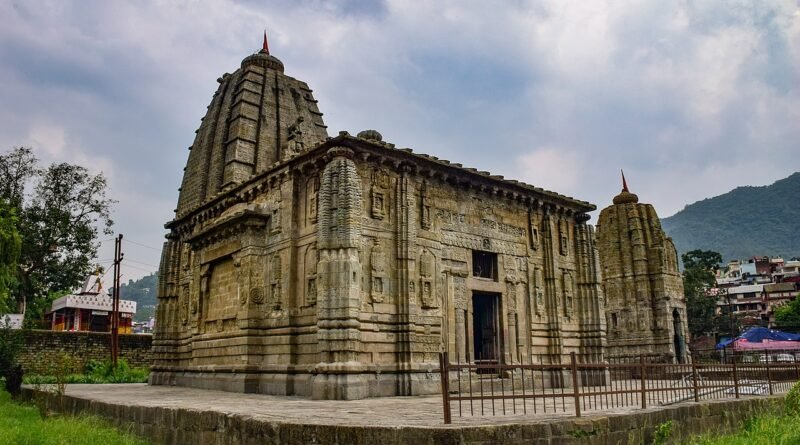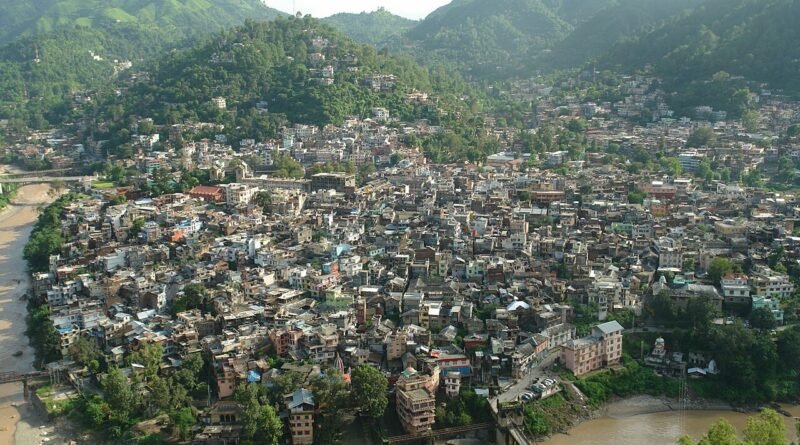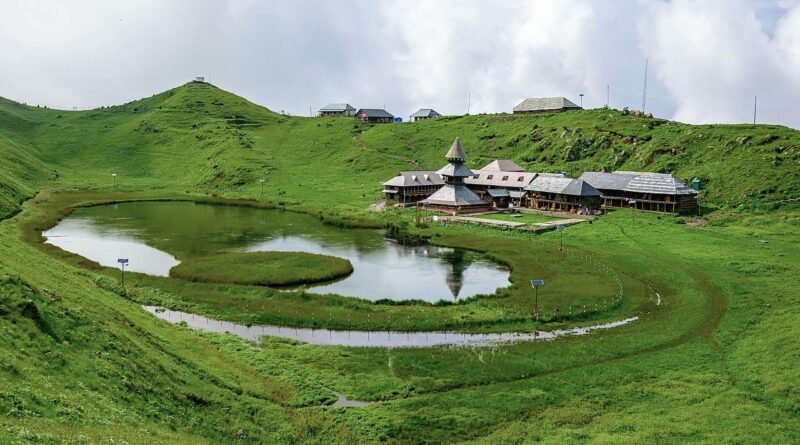Mandi Himachal Pradesh
Mandi (formerly known as Mandav Nagar) is a major city and a municipal corporation in Mandi District in the Indian state of Himachal Pradesh. It is situated 145 kilometres (90 mi) north of state capital, Shimla in the north-west Himalayas at an average altitude of 880 m (2,890 ft) Mandi is connected to the Pathankot through National Highway 20 and to Manali and Chandigarh through National Highway 21. Mandi is approximately 184.6 km (114.7 mi) from Chandigarh, the nearest major city, and 440.9 km (274.0 mi) from New Delhi, the national capital. In the 2011 Indian census, Mandi city had a population of 26,422. Mandi district is currently the 2nd largest economy in the state next to Kangra. Mandi, in the state is having second highest sex ratio of 1013 females per thousand males.
It serves as the headquarters of Mandi District and Zonal Headquarters of central zone including Districts namely Kullu, Bilaspur, and Hamirpur. As a tourist place, Mandi is often referred to as “Varanasi of Hills” or “Choti Kashi” or “Kashi of Himachal”. Also, Mandi is the starting point for a trek of the region, Prashar lake trek. From Mandi, trekkers go to Bagi village, which serves as the base village for Prashar lake. Indian Institute of Technology (IIT) Mandi is a premier institute located 15 kilometres (9.3 mi) from Mandi town.
This one-time capital of the princely state of Mandi is a fast-developing city that still retains much of its original charm and character. The city was established in 1527 by Ajbar Sen,as the seat of the Mandi State, a princely state till 1948. Foundation of the city was laid on the establishment of Himachal Pradesh in early 1948. Today, it is widely known for the International Mandi Shivaratri Fair. First heritage city of Himachal Pradesh. The city also has the remains of old palaces and notable examples of ‘colonial’ architecture. The city had one of the oldest buildings of Himachal Pradesh.
Origin of name
See also: Renaming of cities in India
The name “mandi” (and the former name “Mandav Nagar”) has its roots from Great Sage Rishi ‘Mandav’ who prayed in this area, and the rocks turned black due to the severity of his penance. Alternatively, the name may have been derived from the common word mandi which means “market” in Hindi. It may possibly be connected with the Sanskrit root mandaptika, meaning “an open hall or shed,”.
While the city’s name has always been pronounced “[mŋɖɪ]” in the local language, the anglicized version “Mandav Nagar” was the official name until it was changed to “Mandi”. This change is now the most widely used name for the city. Mandi is renowned for its 81 ancient old stone Shaivite templesand their enormous range of fine carving. Because of this, it is also often called the “Varanasi of the Hills”.
History
The present District of Mandi was formed with the merger of two princely states, Mandi State and Suket State, on 15 April 1948, when the State of Himachal Pradesh was established. Until the mid-20th century, Mandi was on the trade route between Yarkant County and Ladakh to Hoshiarpur and the Indian plains, served as commercial hub and trade centre.
Historical events
Raja Bijai/Vijay Sen, 16th Raja of Mandi
The princely state of Mandi was founded by Bahu Sen in 1200 AD. But Ajbar Sen was the one who founded the historical city of Mandi in 1526 AD. The Chiefs of Mandi State are said to be the descendants of common ancestors of the Chandervanshi line of Rajputs of Sen dynasty of Bengal who claim to be the descendants of Pandavas of Mahabharata times. The present District of Mandi was formed with the merger of two princely states Mandi State and Suket (Sundernagar) on 15 April 1948, when the State of Himachal Pradesh was established. Ajbar Sen assassinated Mandi, it led to the beginning of the modern period of Mandi history. Old Mandi capital was abandoned, and the site of present capital was acquired. Some historians put the selection of present capital in the year 1527 AD. The idol of Madho Rai, the presiding deity of Mandi and incarnation of Lord Vishnu is said to be made by Goldsmith Bhima, in 1648. Maharaja Ranjit Singh occupied Mandi in 1839 but Ranjit Singh died on 27 June 1839. It was beginning of the disintegration of Sikh powers in the hills and British power emerged as most powerful. In 1849, Princely states of Mandi, Suket and Chamba were put under the control of Superintendent ‘Cis-Satluj States’.
Lala Lajpat Rai visited Mandi during 1906 to organize the revolutionary activities. The revolt occurred in Mandi State against the repressive, corrupt and arrogant administration of Raja Bhawani Sen and his Wazir Jiwa Nand Paddha. This revolt was led by Shobha Ram in 1909. A Prominent revolutionary of Mandi, Hardev Ram joined a revolutionary band of patriots in 1913. He went to Shanghai, America and Japan where he met Lala Hardayal and Dr. Mathura Singh. Another revolutionary of Mandi Bhai Hirda Ram started participating in revolutionary activities in 1914. He joined Ras Behari Bose, Sant Baba Wasakha Singh Dadehar, Mathura Singh, Kartar Singh Sarba, Bhai Parma Nand and Pingle. In 1915, on the request of Sarla Devi, wife of Bhai Hirda Ram, the Viceroy converted his death sentence into life imprisonment. In the same year, Nagchala Dacoity in Mandi state took place. In Mandi’s conspiracy case, Mandi revolutionary Sidhu Kharara was sentenced for seven years in 1917. Mandi Legislative Council was constituted in 1933. Swami Purna Nand of Mandi was elected as president of “Himalayan Hill states regional Council” (founded in 1945) & Pt. Padam Dev became its general secretary. The session of “Himalayan Hill states regional Council” was held at Mandi from 8 March 1946 to 10 March 1946. It was also attended by INA activists Dhillon, Sehgal and Shah Nawaz Khan. So finally, Mandi came into existence on 15 April 1948. Suraj Sen ruled over Mandi at time of Damdama Mahal of Mandi.
Before independence
See also: Mandi State
The Chiefs of Mandi State are said to be the descendants of common ancestors of the Chandervanshi line of rajputs of Sen dynasty of Bengal who claim to be the descendants of Pandavas of Mahabharata times. According to the earlier accounts, Bahu Sen established an independent territory and was recognized as a Rana or local Chief. The Raja Ajber Sen, the nineteenth descendant from Bahu Sen, was considered as an able and benevolent ruler. He founded the present Mandi city around the ‘Bhootnath Temple’ in the early 16th century (1500 AD-1534 AD) and shifted his capital to this place from Purani Mandi. The temple of Trilokinath was also constructed during his reign. He was succeeded by Chhattar Sen who built a fort in Kalar by name Lakargarh. The successive rulers of Mandi were Shyam Sen, Gaur Sen, Sidh Sen, Shamsher Sen, Surma Sen, Ishwari Sen, Jalam Sen, Balbir Sen and Vijay Sen. Many public utility, services and facilities like schools, hospitals and post offices, etc., were started by Raja Vijay Sen during his time. He also built large number of palaces and houses. A mule road from Baijnath in District Kangra to Sultanpur in adjoining District of Kullu, via Mandi and the Victoria suspension Bridge on river Beas were constructed during his time in the year 1877. Raja Vijay Sen was issue less and left no direct heir. So in 1897, Bhawani Sen was recognized as his successor. During his period the city was considerably damaged in the earthquake of 1905. He was succeeded by Joginder Sen in April 1914 who was, however, vested with full powers of ruling chief in February 1925. During the period of his minority, Mandi remained under the management of a British officer, and a number of departments were overhauled and reorganised. Mandi being one of the oldest city is enjoying urban status since 1901. The Mandi palace popularly known as “Raj Mahal” as it looked in the past. The area where the “Sunken Garden” exists today was once a pond. mandi is also known as MINI PARIS, due to wide market of clothes and fashionable people.
The predecessor state of Siokot was founded in 1527. Formerly part of the Kingdom of Suket in the Punjab Hills, the dynasty traditionally goes back to 765 AD. In about 1100, Vijaya Sen had two sons, Sahu Sen who ruled over Suket and Bahu Sen who ruled over Kullu. Bahu Sen’s descendants emigrated to Kullu until the tenth descendant, Kabakha Sen was killed by the Raja of Kullu and his son had to flee to Siokot, not very far from the present city of Mandi which was founded during Ajbar Sen’s rule. Since 1986, HH Raja Ashokpal has been the ruler.
After independence
Mandi District was formed by amalgamation of the erstwhile princely states of Mandi and Suket on the formation of Himachal Pradesh on 15 April 1948. Since then, it is serving as the district headquarters of the Mandi District. Mandi district comprises 7 Tehsils namely Joginder Nagar, Sarkaghat, Sundar Nagar, Sadar Mandi, Chachyot, Thunag, Karsog and 9 Sub-Tehsils, i.e., Ladbharol, Padher, Sandhole, Dharmpur, Makreri, Baldwara, Nihri, Kotli, Aut, Bali Chowki.
For the purpose of development activities, the District has been divided into 10 Blocks. The District has a total population of 9,00,987 persons as per 2001 Census and area of 3,950 km2. and covers 7.10% area of the State. The District has six cities including Pandoh as census city. These are namely Mandi, Sunder Nagar, Joginder Nagar, Rewalsar, Sarkaghat and Pandoh. Recently Mandi has become Zonal Headquarters of Central Zone, which covers the Districts of Bilaspur, Hamirpur, Kullu and Mandi itself and has gained much importance from administrative point of view.
Municipal Council
Nagar Parishad Mandi was constituted during 1950. It has 13 wards consisting of 10 Revenue hadbasts. In 2020, it has now become a Municipal Corporation with 15 wards presently having population of 41375 with 14626 households.













